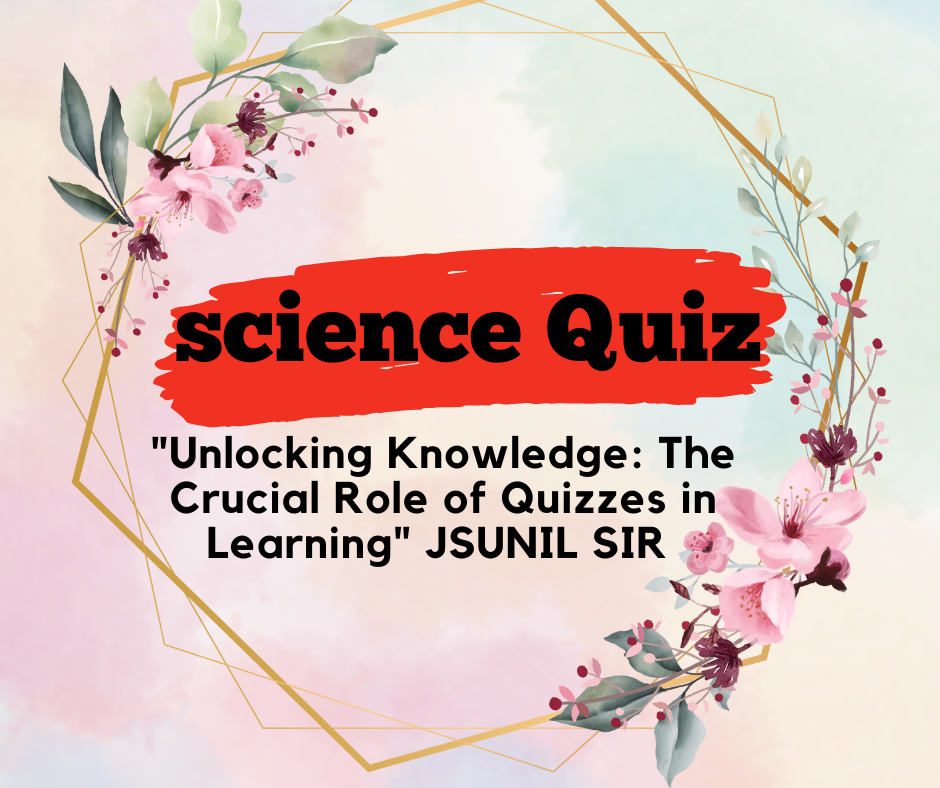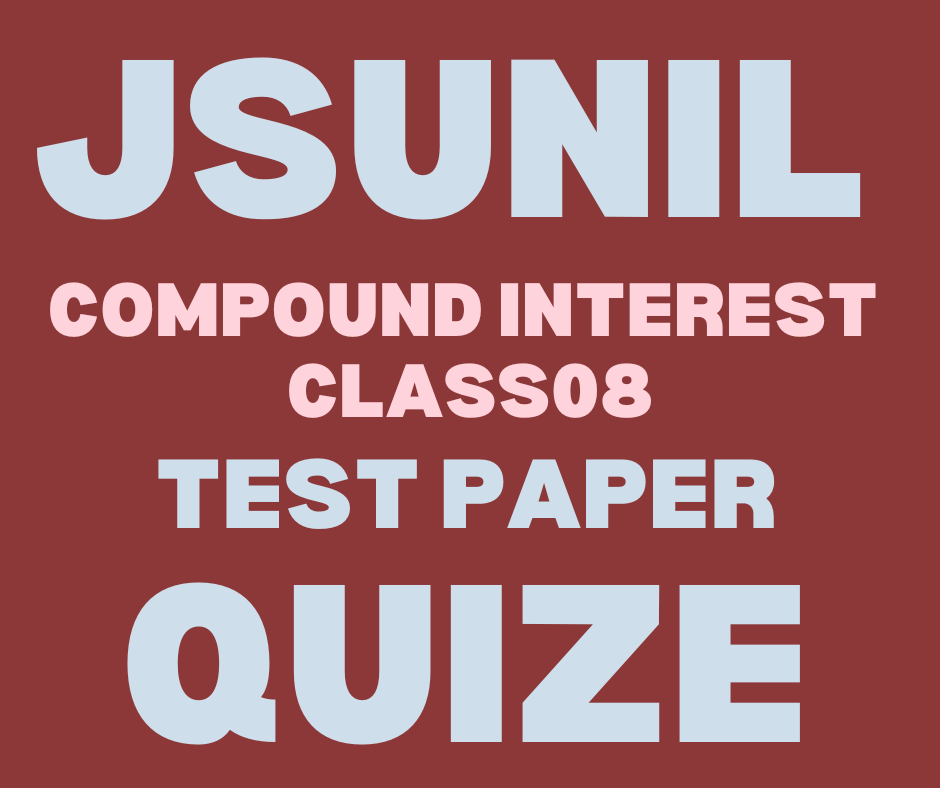Interective Quiz: Light, Reflection, Refraction, Lenses, and Mirrors by JSUNIL SIR for Std. 08 and 10
"Unlocking Knowledge: The Crucial Role of Quizzes in Learning"
Here's a quiz based on the topics of light, reflection, refraction, refractive index, magnification, image formation by lenses and mirrors, and power of lenses:1. What is the angle of incidence equal to in relation to the angle of reflection?
a) Half the angle of reflection
b) Equal to the angle of reflection
c) Twice the angle of reflection
d) Not related to the angle of reflection
2. When light passes from air to water, it tends to:
a) Speed up
b) Slow down
c) Remain unchanged
d) Reverse direction
3. Refractive index is defined as the ratio of the speed of light in a vacuum to its speed in a medium. What is its symbol?
a) v
b) n
c) c
d) λ
4. What type of mirror always forms a virtual, erect, and diminished image?
a) Convex mirror
b) Concave mirror
c) Plane mirror
d) Spherical mirror
5. A lens with a focal length of +10 cm is:
a) Convex lens
b) Concave lens
c) Plano-convex lens
d) Biconcave lens
6. The image formed by a convex lens for an object placed beyond 2F is:
a) Real and inverted
b) Virtual and inverted
c) Real and erect
d) Virtual and erect
7. The ability of a lens to converge or diverge light rays is measured by its:
a) Refractive index
b) Focal length
c) Power
d) Magnification
8. The bending of light when it passes from one medium to another is called:
a) Dispersion
b) Reflection
c) Diffraction
d) Refraction
9. The image formed by a concave lens is always:
a) Real and inverted
b) Virtual and inverted
c) Real and erect
d) Virtual and erect
10. When an object is placed between F and 2F of a concave lens, the image formed is:
a) Real, inverted, and magnified
b) Real, inverted, and diminished
c) Virtual, erect, and magnified
d) Virtual, erect, and diminished
Answers:
1. b) Equal to the angle of reflection
2. b) Slow down
3. b) n
4. a) Convex mirror
5. a) Convex lens
6. d) Virtual and erect
7. c) Power
8. d) Refraction
9. d) Virtual and erect
10. a) Real, inverted, and magnified
Happy and enjoyable Learning!
JSunil Tutorial 🌐
Interactive Quiz 02 : Light and Optics
1. What is the law of reflection?
a) Light travels in straight lines
b) Angle of reflection = Angle of incidence
c) Light is composed of particles called photons
d) Light changes direction when passing through a medium
2. When does total internal reflection occur?
a) When light enters a less dense medium
b) When light enters a denser medium
c) When the angle of incidence is greater than the critical angle
d) When light passes through a transparent material
3. What is the refractive index of a medium?
a) The speed of light in a vacuum
b) The angle of reflection
c) The ratio of the speed of light in a vacuum to the speed of light in the medium
d) The frequency of light in the medium
4. What causes an object to appear larger or smaller when viewed through a lens?
a) Magnification
b) Reflection
c) Refraction
d) Dispersion
5. Which type of lens converges light rays to a point?
a) Convex lens
b) Concave lens
c) Bifocal lens
d) Plano-convex lens
6. How is an image formed in a plane mirror?
a) Real and inverted
b) Virtual and upright
c) Real and upright
d) Virtual and inverted
7. Which of the following is not a type of mirror?
a) Concave mirror
b) Convex mirror
c) Plane mirror
d) Diverging mirror
8. The power of a lens is measured in:
a) Watts
b) Diopters
c) Newtons
d) Lumens
9. What is the focal length of a lens?
a) The distance between the lens and the object
b) The distance between the lens and the image
c) The point where parallel light rays converge after passing through the lens
d) The point where light rays diverge before passing through the lens
10. What type of image does a convex lens form for an object placed beyond its focal point?
a) Real and inverted
b) Virtual and upright
c) Real and upright
d) Virtual and inverted
Answers:
1. b) Angle of reflection = Angle of incidence
2. c) When the angle of incidence is greater than the critical angle
3. c) The ratio of the speed of light in a vacuum to the speed of light in the medium
4. a) Magnification
5. a) Convex lens
6. b) Virtual and upright
7. d) Diverging mirror
8. b) Diopters
9. c) The point where parallel light rays converge after passing through the lens
10. b) Virtual and upright
Test your understanding of light and optics, and discover the wonders of how light behaves and interacts with lenses and mirrors. Good luck!
Quiz 03: Refractive Index, Magnification, Image Formation by Lens, and Lens Power
1. What is the refractive index of a vacuum or air?
a) 0
b) 1
c) 2
d) 0.5
2. When an object is placed beyond the focus of a convex lens, the image formed is:
a) Real and inverted
b) Virtual and inverted
c) Real and upright
d) Virtual and upright
3. The formula for magnification (m) in lenses is:
a) m = h_i / h_o
b) m = h_o / h_i
c) m = f_i / f_o
d) m = f_o / f_i
4. A concave lens always forms a virtual image because it:
a) Has a negative focal length
b) Has a positive focal length
c) Is thinner at the center
d) Is thicker at the center
5. The power of a lens is measured in:
a) Diopters (D)
b) Watts (W)
c) Newtons (N)
d) Volts (V)
6. A lens with a focal length of +10 cm has a power of:
a) +0.1 D
b) -0.1 D
c) +10 D
d) -10 D
7. The refractive index of a medium is the ratio of the speed of light in a vacuum to the speed of light in that medium. True or False?
8. In a magnifying glass, the image formed is:
a) Virtual and erect
b) Real and inverted
c) Virtual and inverted
d) Real and erect
9. The focal length of a lens is the distance between the lens and its focus point. True or False?
10. When light passes from a medium with a higher refractive index to a medium with a lower refractive index, it bends away from the normal. This phenomenon is called:
a) Reflection
b) Diffraction
c) Refraction
d) Dispersion
**Answers:**
1. b) 1
2. b) Virtual and inverted
3. a) m = h_i / h_o
4. a) Has a negative focal length
5. a) Diopters (D)
6. a) +0.1 D
7. True
8. a) Virtual and erect
9. False
10. c) Refraction
Good luck with the quiz!
Put your feedback in comment box and share with friends





Comments
Post a Comment